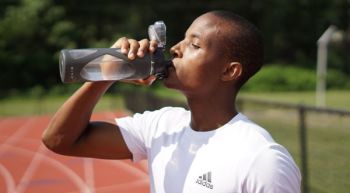NUTRITION CONSIDERATIONS FOR EXERCISING IN THE HEAT – Elle Kelly, RD
Posted on
 When it comes to participating in sports and physical activities during hot weather, attention to nutrition and hydration becomes even more crucial - especially here in the UK where we are not exactly used to the heat.
When it comes to participating in sports and physical activities during hot weather, attention to nutrition and hydration becomes even more crucial - especially here in the UK where we are not exactly used to the heat.
When exercising in the heat, the body’s response is to transfer heat away from the body by diverting blood flow to the skin.1 However, this compromises blood flow to the working muscles and gastrointestinal system, which can lead to gastrointestinal symptoms such as nausea, abdominal cramps and diarrhoea.
A study found that the overall incidence of lower gastrointestinal issues, such as abdominal cramps, was more than twice as likely in hot and humid conditions in comparison to mild weather conditions, despite the intensity of exercise being the same. Upper gastrointestinal symptoms, such as bloating and reflux, also increased from 40% to 90% when exercising in the hotter climate.2
These effects are not only uncomfortable but can impact performance too.3,4 The risk of gastrointestinal issues arising when exercising in the heat can be minimised by the following two strategies:
1 Strategic meal planning
Eating too close to a workout can cause digestive discomfort when exercising, as blood flow is diverted away from the gut to the working muscles. Aiming to consume a balanced meal two or three hours before activity allows sufficient time for digestion and a slow release of energy to provide fuel for the workout.
However, this might not always be feasible. Choosing a carbohydrate-rich snack 30-60 minutes before a workout can be helpful as it provides fast-acting energy and can be digested easily. High-fibre and high-fat foods take a while to be digested and should be avoided ahead of a workout to avoid aggravating gastrointestinal symptoms.
2 Starting hydrated, staying hydrated and rehydrating!
 During hot and humid conditions, sweating increases as a way to keep the body cool. Sweating leads to fluid and electrolyte losses regardless of the weather, but sweating at an accelerated rate, which can happen in hot conditions, puts an individual at a greater risk of dehydration.5 Dehydration can impact performance by causing digestive issues, early onset fatigue, increasing the perception of effort, increased heart rate and impaired cognitive performance, which could also put an individual at an increased risk of heat stroke and injury.6
During hot and humid conditions, sweating increases as a way to keep the body cool. Sweating leads to fluid and electrolyte losses regardless of the weather, but sweating at an accelerated rate, which can happen in hot conditions, puts an individual at a greater risk of dehydration.5 Dehydration can impact performance by causing digestive issues, early onset fatigue, increasing the perception of effort, increased heart rate and impaired cognitive performance, which could also put an individual at an increased risk of heat stroke and injury.6
- Before – It is important to start exercise hydrated in order to lower the risk of becoming dehydrated during exercise. Aiming for a clear or pale-yellow coloured urine is a useful way to measure adequate hydration.
- During – Drinking to thirst is normally recommended during a training session, with water being sufficient in most cases. However, if sessions are intense or last more than 90 minutes, a drink that provides carbohydrates and electrolytes may be required, such as a sports drink or diluted fruit juice.
- After – Fluid and electrolyte losses can be replaced by drinking a comfortable amount of water and having food after a workout. Depending on the length and the intensity of a session, drinks like flavoured milk or a sports drink can also be good options for rehydrating, as these will provide sodium, which is lost through sweat. These also provide a source of carbohydrate to help to replenish glycogen stores.
It is not recommended to drink a large amount of fluid straight away, as this can increase the risk of hyponatraemia, where sodium levels drop, due to increased urination.7,8
CONCLUSION
Exercising in the heat can exacerbate digestive stress, but by being mindful of meal timings, foods that may trigger symptoms and staying hydrated, the risk can be minimised. Everyone is different, and it may take some trial and error to find the right approach.
Elle Kelly, RD, BSc, MSc
Specialist Dietitian, self-employed
Elle is a freelance dietitian and runs a clinic supporting clients
with eating disorders, disordered eating and athletes looking
to improve their performance and relationship with food.
Instagram: @ellekellynutrition
Website: eknutrition.com
References
- González‐Alonso J, Crandall CG & Johnson JM (2008). The cardiovascular challenge of exercising in the heat. The Journal of Physiology, 586(1), 45-53
- Snipe RMJ, Khoo A, Kitic CM, Gibson PR & Costa RJS (2018). The impact of exertional-heat stress on gastrointestinal integrity, gastrointestinal symptoms, systemic endotoxin and cytokine profile. European Journal of Applied Physiology,118(2), 389-400. https://doi.org/10.1007/s00421-017-3781-z
- Costa RJ, Mika AS & McCubbin AJ (2022). The impact of exercise modality on exercise-induced gastrointestinal syndrome and associated gastrointestinal symptoms. Journal of Science and Medicine in Sport, 25(10), 788-793
- Costa RJS, Snipe RMJ, Kitic CM & Gibson PR (2017). Systematic review: exercise‐induced gastrointestinal syndrome - implications for health and intestinal disease. Alimentary Pharmacology & Therapeutics, 46(3), 246-265
- Sports Dietitians Australia. Fluid in Sport Fact Sheet. https://www.sportsdietitians.com.au/factsheets/fuelling-recovery/fluids-in-sport/
- Garcia CK, Renteria LI, Leite-Santos G, Leon LR & Laitano O (2022). Exertional heat stroke: pathophysiology and risk factors. BMJ Medicine, 1(1)
- Klingert M, Nikolaidis PT, Weiss K, Thuany M, Chlíbková D & Knechtle B (2022). Exercise-Associated Hyponatremia in Marathon Runners. Journal of Clinical Medicine, 11(22), 6775
- Armstrong LE (2021). Rehydration during endurance exercise: challenges, research, options, methods. Nutrients, 13 (3), 887
